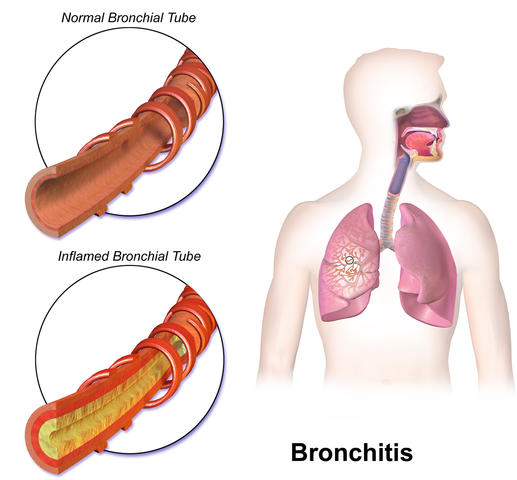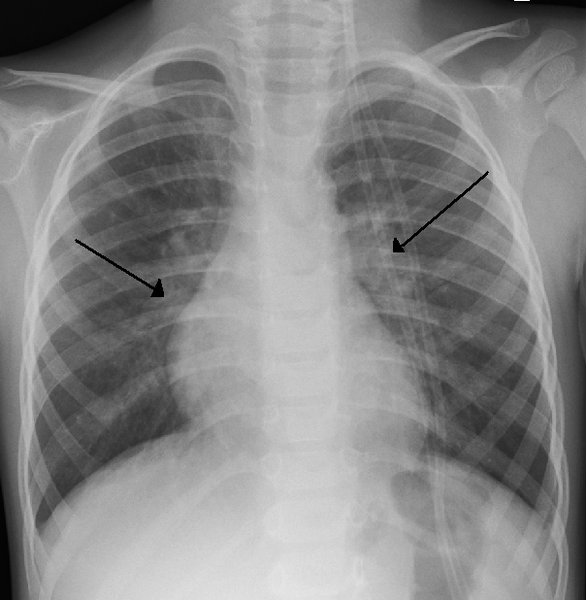Difference Between Bronchitis and Bronchiolitis
What is Bronchitis?
Definition of Bronchitis:
Bronchitis is the condition in which the bronchi and trachea of the upper respiratory tract become inflamed. The bronchi are the breathing tubes which branch off from the windpipe, the trachea. Bronchitis is often a complication that arises from some sort of infection of the upper respiratory tract.
Symptoms of Bronchitis:

The symptoms include a mainly nonproductive cough, sometimes production of sputum, chest pain and tightness with some degree of difficulty with breathing. Low pitched rattling wheezing sounds can be heard which indicate congestion. Symptoms usually last more than 5 days and can take as long as two to three weeks to completely disappear.
Diagnosis and causes of Bronchitis:
Bronchitis can be diagnosed based on a physical exam and after a chest x-ray has ruled out other conditions. Bronchitis is caused by a virus most of the time (greater than 95% of cases). The viruses that most often cause bronchitis, are rhinovirus and the influenza type A or type B virus. The respiratory syncytial virus can also cause bronchitis as can coronavirus or parainfluenza virus. Chronic conditions such as COPD, smoking, and cystic fibrosis can cause the chronic form of bronchitis.
Risk factors and treatment:
Cigarette smoking is a risk factor for chronic bronchitis, as is having COPD or cystic fibrosis. Having an upper respiratory tract infection is a risk factor for developing acute bronchitis. Treatment usually involves relieving the symptoms by taking anti-inflammatory medications or painkillers. Beta2- antagonists such as albuterol can be given, which the patient inhales. The beta2-antagonists help a great deal with the wheezing and tightness of the chest. Antibiotics are usually not recommended since infections are mainly viral.

What is Bronchiolitis?
Definition of Bronchiolitis:
Bronchiolitis is a condition in which the lower respiratory tract is infected and inflamed because of an acute infection from a virus. This illness occurs in infants who are less than 2 years old.
Symptoms of Bronchiolitis:
Infants present with symptoms such as a wheezing and hacking type of a cough and fast rate of breathing, as well as difficulty in breathing. Oxygen levels may be low leading to cyanosis (bluish-tinge) in severe cases. Infants may have vomiting leading to dehydration and they may also have an ear infection at the same time.
Diagnosis and causes:
Diagnosis of the condition is made by physical exam, pulse oximetry (which measures oxygen levels), and chest x-rays. In severe cases, chest X-rays may show changes in the lungs such a hyperinflation. A test for the RSV antigen can be helpful. Bronchiolitis is caused by viruses including parainfluenza virus type 3, respiratory syncytial virus (RSV), and rhinovirus.
Risk factors and treatment:
Infants who are born prematurely have a higher risk of bronchiolitis. Studies have shown that babies born to mothers who smoke are at increased risk. Other risk factors include being male and living in crowded conditions, and exposure to RSV. Since the condition is caused by a virus the treatment is supportive care and related to the symptoms. Treatment may include giving fluids and oxygen therapy. In very severe cases of bronchiolitis, infants may need to be hospitalized.
Difference between Bronchitis and Bronchiolitis?
-
Definition
Bronchitis is inflammation of the bronchi and trachea while bronchiolitis is infection and inflammation of the lower respiratory tract.
-
Age affected
Bronchitis can affect people of all ages from infants to the elderly. Bronchiolitis only affects infants who are younger than two years of age.
-
Symptoms
Coughing, wheezing and difficulty breathing is a symptom of bronchitis. Coughing, wheezing, fast rate of breathing, difficulty breathing, cyanosis, and vomiting are symptoms seen in bronchiolitis.
-
Diagnosis
Bronchitis is diagnosed by physical exam and by the use of chest X-rays to exclude other possible conditions. Bronchiolitis is diagnosed by physical exam, pulse oximetry, chest X-rays and RSV antigen tests.
-
Causes
Acute bronchitis can be caused by RSV, coronavirus, parainfluenza virus, influenza type A, and influenza type B virus. Chronic bronchitis can be caused by smoking cigarettes. Bronchiolitis can be caused by RSV, rhinovirus, and parainfluenza virus type 3.
-
Risk factors
A risk factor for chronic bronchitis is smoking or having COPD. A risk factor for acute bronchitis is having an upper respiratory tract infection. A risk factor for bronchiolitis is being premature, a male infant, being born to a mother who smokes, and living in crowded conditions.
-
Treatment
Bronchitis can be treated by the use of anti-inflammatory and pain medications and beta2-antagonists (such as albuterol), that are inhaled. Bronchiolitis is treated with fluids and oxygen therapy.
Table comparing Bronchitis and Bronchiolitis

Summary of Bronchitis Vs. Bronchiolitis
- Bronchitis is an inflammation of the upper respiratory tract while bronchiolitis is an infection and inflammation of the lower respiratory tract.
- Both bronchitis and bronchiolitis are caused by viruses.
- Bronchitis is an illness that can occur in a person at any age while bronchiolitis is usually only found in infants who are younger than two years of age.
- Symptoms of bronchitis and bronchiolitis are similar but bronchiolitis can also cause vomiting leading to dehydration.
- Bronchitis is not normally evident on a chest X-ray but bronchiolitis can sometimes be seen on a chest X-ray since it can causes changes in the lungs.
- Both conditions require supportive care.
- Difference Between Caucus and Primary - June 18, 2024
- Difference Between PPO and POS - May 30, 2024
- Difference Between RFID and NFC - May 28, 2024
Search DifferenceBetween.net :
1 Comment
Leave a Response
References :
[0]Bhatia, Rajeev. “Bronchiolitis”. Merckmanuals. Merck & Co., 2018, https://www.msdmanuals.com/professional/pediatrics/respiratory-disorders-in-young-children/bronchiolitis
[1]Lanari, Marcello, et al. "Risk factors for bronchiolitis hospitalization during the first year of life in a multicenter Italian birth cohort." Italian journal of pediatrics 41.1 (2015): 40.
[2]Sethi, Sanjay. “Acute bronchitis”. Merckmanuals. Merck & Co., 2018, https://www.msdmanuals.com/professional/pulmonary-disorders/acute-bronchitis/acute-bronchitis
[3]Image credit: https://upload.wikimedia.org/wikipedia/commons/thumb/7/77/RSV.PNG/586px-RSV.PNG
[4]Image credit: https://upload.wikimedia.org/wikipedia/commons/thumb/1/1c/Bronchitis.png/517px-Bronchitis.png

Just a heads up, albuterol is a beta 2 agonist, not an antagonist